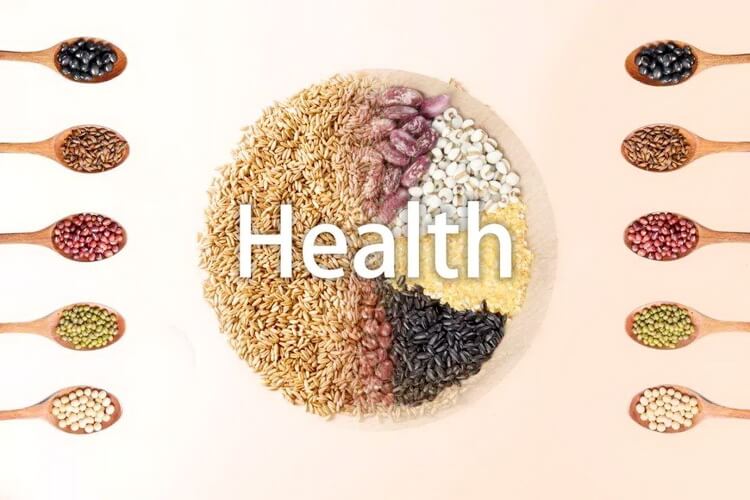How to eat healthily? You need a lifestyle change
A good diet is essential for a body's healthy growth and development. Through a reasonable diet, rich nutrition can have a healthy body. Switch up a few daily habits – like replacing white bread with whole grains – and you'll unlock the secret to nutritional noshing and better health.

Whole grain
As part of a generally healthy diet, whole grains consumption is associated with a lower risk of several diseases. Whole grains are a source of Carbohydrates, multiple nutrients, and dietary fiber. Your body will thank you for rethinking your wheat choices to include more whole grains. They are rich in nutrients such as vitamin B, magnesium, iron, and zinc, but choosing whole grains may also reduce your risk of heart disease, stroke, certain cancers, and diabetes. A source of fiber, whole grains can also help fill you up, which helps with healthy weight management.
★Whole grain sources
Options abound, including brown rice, wild rice, barley, quinoa, rye, buckwheat, oats, amaranth seeds, wheat varieties (such as farro, Kamut, and durum) and wheat forms (such as bulgur and cracked wheat), to name but a few.
Look for whole grains listed first on the ingredient list, such as "whole rye" or "whole-grain whole wheat flour"; otherwise, a product that. States "made with whole grain" may be made with refined grain and just a bit of whole grain added, and "multigrain" may not contain whole grains at all but rather a selection of different grains. To get more whole grains, make a marinated salad using barley, farro, or red rice tossed with vegetables, cheese, and beans to pack into lunch boxes. Extra cooked grains can be tossed into soups and stews. Cooked quinoa can be sprinkled on salads, added to smoothies, baked in a frittata, or made into quinoa "fried rice."
★Daily Value
Recommends between six and eight servings of grain products per day for adults, with half of a small whole-grain bagel or 1/2 cup of cooked brown rice representing one serving. Of these grain products, strive to make at least half of them a variety of whole grains.
DF(dietary fiber)
Dietary fibers can act by changing the nature of the contents of the gastrointestinal tract and by changing how other nutrients and chemicals are absorbed. There are two main types of fiber, and both are important for maximizing health benefits. Soluble fiber (found in carrots, oats, and apples) helps with lowering cholesterol and controlling blood glucose, while insoluble fiber (found in wheat bran and whole grains) helps maintain regular bowel function. Replace empty calories with more fiber-rich foods. It's a simple switch to make because there are lots of tasty options.
The health benefits are numerous: You can better control blood sugar levels and diabetes, lower cholesterol, maintain healthy body weight, and promote regularity. Research also indicates that a diet high in fiber may lower your risk of heart disease and colon cancer.
★Best food sources of dietary fiber
Nuts and seeds, such as almonds, ground flax, and sunflower seeds, are good sources of fiber, as are whole grains, such as oats, brown rice, quinoa, and barley. (why we need dietary fiber? click here)
From the legume family, fiber-filled options include lentils, split peas, corn, edamame, chickpeas, black beans, and lima beans, while a veritable rainbow of fruits and vegetables, such as apples and pears (especially with the skins), most berries, figs, dried apricots, prunes, broccoli, peas, winter squash, and sweet potatoes, also contains a healthy hit of fiber. For a fiber-packed snack that's portable, too, spread almond butter on apple slices, or make your own trail mix with air-popped popcorn, dried blueberries, walnuts, and high-fiber cereal.
★Daily Value
As a daily target, aim for a total of at least 25 grams of both soluble and insoluble fiber spread out over a number of meals and snacks throughout the day, as overloading the digestive system with too much fiber all at once can lead to bloating and gas.
Drink plenty of water throughout the day, and exercise regularly to help keep fiber moving along. Also, check the nutrition information on package labels and choose high-fiber whole grains more often. Foods labeled "high fiber" must contain at least four grams of fiber per serving, while a "source" of fiber has a minimum of two grams of fiber per serving.

Omega-3 fatty acid
You don't have to get rid of fat; you just need to switch the types you're eating. Healthy fat that offers up a host of nourishing benefits, omega-3 polyunsaturated fatty acids help lower "bad" (LDL) cholesterol levels and may help reduce your risk of heart disease and stroke. Omega-3 fats have also been shown to reduce inflammation and improve bone and joint health, while preliminary research indicates that consumption of these essential fats may also be beneficial in reducing your risk of dementia, depression, and some cancers.
Collectively important to overall good health, the three types of omega-3 include eicosapentaenoic acid (EPA) and docosahexaenoic acid (DHA), or "long-chain" fatty acids that are found in fatty fish and algae, and alpha-linolenic acid (ALA), an omega-3 "short-chain" fatty acid found in many plant-based foods.
★Dietary sources
There are plenty of fish in the sea that provides heart-healthy omega-3 fatty acids, including oily options such as salmon, rainbow trout, tuna,
anchovies and sardines. Along with these marine sources, plant-based foods that are notable sources of omega-3s include canola oil, walnuts, and edamame. Another rich source of ALA omega-3s, ground flaxseed can be added to yogurt, smoothies, cereals, muffins, bread, and salads (for a simple, healthy salad dressing, whisk flaxseed oil with cider vinegar, a touch of honey, sea salt and freshly ground pepper and keep in a jar in the refrigerator).
★Daily Value
Whether for cooking, dressings spread, or other recipes, recommends a total of two or three tablespoons of healthy fats per day, at least two servings of fish per week. For best sources, choose fish that are higher in omega-3, such as salmon, sardine, herring, mackerel, anchovies, menhaden, etc. The World Health Organization recommends regular fish consumption (1-2 servings per week, equivalent to 200 to 500 mg/day EPA + DHA) as protective against coronary heart disease and ischaemic stroke. Most of us could benefit from incorporating more omega-3 fats into our diet but check with your doctor before considering omega-3 supplements.